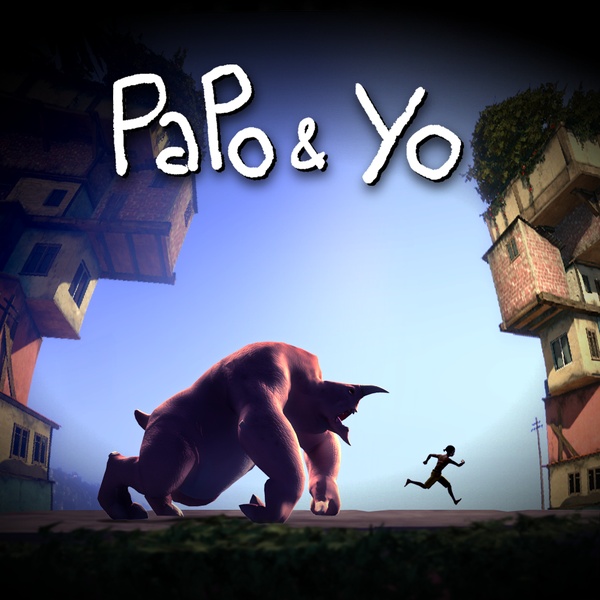The pounding in my chest and the sobs choking in my throat riding off of Papo & Yo’s pitch perfect crescendo told me exactly how I felt about the game. The odd thing was that I couldn’t actually think of what specific moment or image had brought me to that point. I was sad, and I didn’t know why.
That disconnect is perhaps Papo & Yo’s greatest achievement – conveying emotion while denying the necessity of plot.
Certainly, there is a story behind Papo & Yo. It’s a tale of anger, abuse and one’s inability to cope with reality that may only be totally understood by gamers. More explicitly, it’s about a boy named Quico (kee-ko) trying to cure his monstrous sometimes-ally, sometimes-enemy, Monster, of his destructive tendencies. To do this, Quico must manipulate Monster’s love of coconuts (which will lure the creature’s attention to specific points). Meanwhile, if Monster manages to get his hands on a tasty yet poisonous frog, he will lose control of his temper and violently turn on Quico.
However, Papo & Yo uses its medium – the very fact that it is a video game — rather than its plot as a conduit for emotional payoff. Those rules inherent to video games, such as the inherent desire to avoid anything harmful and classify it as an “enemy,” once examined in their context, become sources of fear, sadness and remorse.
The uncertainty and surrealism of the actual ‘plot’ mean that these tropes can apply to anything or anyone, depending on the player. Monster — with his shifting roles simple motivations – can become an allegory for whatever demon from your past that you choose. In my case, Papo & Yo was oddly poignant, dredging up my own, past struggle with anger and a tough relationship with my father. While the specifics of the message will of course vary from player to player, I find it hard to believe that anyone doesn’t have some demon from their past just waiting to be brought to the surface.
For a game that so heavily relies on the experience of playing it, it’s surprising that Papo & Yo’s gameplay never finds its own tempo.
Quico moves stiffly and suddenly, with next to zero analog control. That’s especially a problem since the game’s environments are riddled with rough level geometry. Nothing derails character movement quite like an encounter with invisible walls and bumps where they clearly weren’t meant to be. And nothing quite derails a platformer like bad character movement. This might have been alleviated by a less Spartan allotment of traditional traversal options, such as clinging to ledges or clambering up objects. As it stands, all you can really do in Papo and Yo is run, jump and, eventually, hover in the air for a few short seconds.
The saving grace of the gameplay is that there is no way to die in Papo & Yo. Any time you misjudge your leap across space, you’re simply replanted on the last stable surface you came into contact with. Perhaps this is a bit of a cheat, but it does keep the game from dipping into frustration too frequently.
What this blend of problems and workarounds leaves you with is something that feels like it was built by coders, rather than level designers.
The puzzle half of the equation fares a bit better. The game’s gentle, serviceable puzzles are carried primarily by the art style’s sense of magic realism. The site of whole buildings from a Brazilian favela suddenly growing legs or wings of chalk and stacking only to stack atop one another or split into staircases is so charmingly unique that you’ll likely forgive the fact that all you did to make it happen was flip a switch.
The bland gameplay definitely starts Papo & Yo off key, but you’ll quickly forget that it was ever an issue as you’re drawn into the ever more intense emotional stresses of the rest of the game up until the final moments that left me in the state I mentioned at the beginning of this review.
Papo & Yo does for sadness and remorse what Amnesia: The Dark Descent did for fear and paranoia. By stripping away the majority of traditional plot and exposition, your imagination is left to create and recall things much worse and more personal than anything the developers could create by themselves. Papo & Yo is what you and your memories allow it to be.
While the game’s shortcomings are just that, I never assumed that the developers were attempting to make something that was fun (clearly, the overall tone of the game isn’t meant to instill happiness) and they haven’t. In some ways, Papo & Yo being ‘fun’ would have been antithetical to the experience.
What the developers have done instead, intentionally or not, is craft an experience that eschews the very notion that games and art needs to be enjoyable. The gameplay is uninspired enough so as not to interfere with the core objective, but not bad enough to be frustrating.
If you’re just looking to have a good time, than there are plenty of other games out there for you. However, if you’re ready to intentionally explore a more difficult side of your own emotions, than Papo & Yo is the best – and only – game in its league.
This review is based on a copy of the game provided to SideQuesting by Sony.






No Comments